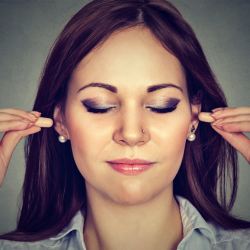Ask yourself how often you ever think about your ability to hear? How much you value it? How much you—and your loved ones—would be impacted if it were gone or profoundly diminished?
How much you would intervene early and often if you knew it would best protect this precious sense?
Well, the Centers for Disease Control and Prevention (CDC) recognizes our natural tendency not to appreciate things as much as we should until we don’t have them any more, so they recently studied the extent of adult hearing loss and modifiable ways to prevent it. The most significant finding was that much hearing damage and loss is occurring from loud sounds experienced in our daily lives, homes and community environments. (1)
These noise-induced deficits are permanent and appear with prominence at early ages—1 in 5 young adults aged 20-29 years increasing to 1 in 4 in those 50-59 years old. Hearing loss is the third most common chronic physical condition. (2)
The bad news: Presbycusis (age-related hearing loss, typically a gradual process) is a fact of life until we learn how to circumvent the aging process. Since I am ageless and sticking to that classification, I will let you know how mind over matter turns out in staving this eventuality off. In addition, certain disease states, like diabetes and cancer, along with specific medications can also contribute to this reality.
In the mean time, there is good news: Noise-related hearing loss and its extent of damage can be modifiable with behavioral changes and preventive measures. The lesson is to start now!
Hearing is a gift that allows us to interact with the world. Make social connections. Actively participate without limitation. Thankfully, modern medicine affords us alternatives when it is damaged, but this loss is not without consequences to our health and well-being. In fact, when it is left untreated loneliness, stress, social isolation, diminished cognition, anxiety and depression can result. Worsening heart disease, elevated blood pressure and other untoward effects often accompany chronic noise exposure as well.(3) If you hear ringing in your ears (e.g. tinnitus) or are highly sensitive to commonplace sounds (e.g. hyperacusis) or are challenged to follow conversations amid routine ambient noise, then these could be signs of problems.
The CDC projects the total cost of first-year hearing loss treatment will increase fivefold between 2002-2030 to $51.4 billion. (4)
Yes, those with occupational noise exposures are at high risk of hearing damage; however, those conditions typically are regulated to a certain degree and gear is worn to minimize negative effects. Much improvement in that arena is constantly being evaluated as completely preventing loss is unrealistic. But, in everyday activities focus on preservation of hearing is not at the forefront of our minds.
This new study is alerting us that it should be a consideration and awareness can only help.
CDC researchers —in conjunction with support from the National Institute on Deafness and other Communications Disorders, National Institute of Health— analyzed 3,583 hearing tests and questionnaire data in the 2011-2012 National Health and Nutrition Examination Survey (NHANES) of 20-69 year old adults to decipher the harm caused by noise. Males exhibited higher rates of loss as did those people, in general, who reported good or excellent hearing. Hearing loss and damage precede perception.
Though it was determined that noise-induced destruction is quite significant, it was also recognized that preventive efforts could avoid damage and stop progression. Especially when initiated earlier in life. As always, it was not a perfect study given how complex the issue is and the unknown contribution of genetic factors or disease states that might be meaningful underlying influences. That said, noise is a modifiable risk factor that can often be controlled. It is in our best interest to do so when feasible while balancing this consideration with enjoying life.
Prevention Tips:
- Avoid protracted exposure to loud environments and wear protective gear (in particular when using leaf blower, attending concerts or sporting events, around sirens and so on…)
- Be sure your work environment is following noise regulations and is current on policy changes
- Reduce listening time to high volumes—take breaks
- Be proactive—Avoid sitting next to the loud speaker in a stadium or ask a restaurant to turn down its music, for example
- CDC’s National Institute for Occupational Safety and Health (NIOSH) recommends wearing hearing protection whenever noise >85 db(A) regardless of length of exposure (5)
- Discuss with your doctor routine monitoring of hearing and ways to adjust your environment — this is especially important if you are at higher risk (e.g. on ototoxic medication, diabetic, occupational hazards, exposed to loud sounds in daily life)
- Remember, there can be damage without symptoms, so simply being aware is a crucial first step.
SOURCES:
(1) (3) New Vital Signs study finds noise-related hearing loss not limited to work exposure. CDC. February 7, 2017.
(2) (4) (5) Vital Signs: Noise-Induced Hearing Loss Among Adults—United States 2011-2012. CDC. Weekly. February 7, 2017. 66(5);139-144.
National Institute on Deafness and Other Communication Disorders (NIDCD): Age-Related Hearing Loss
Centers for Disease Control and Prevention (CDC): Too Loud! For Too Long!

